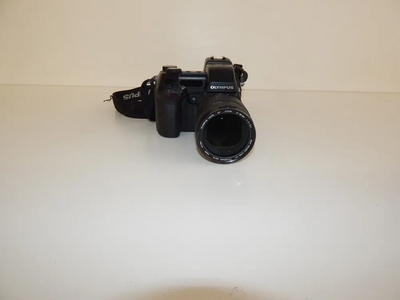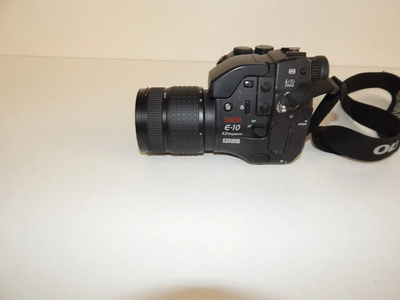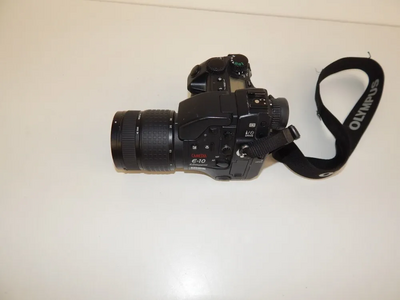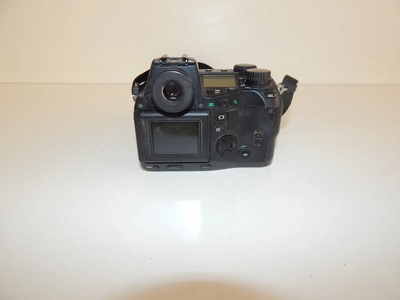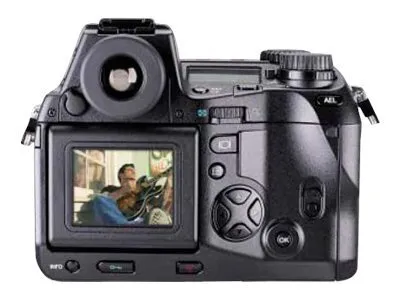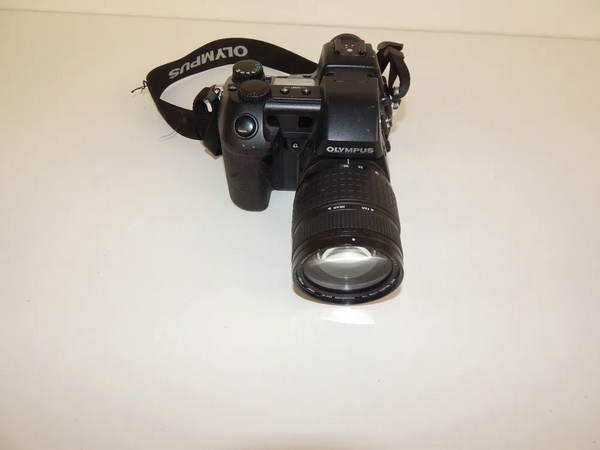
Olympus E-10
| Brand | Olympus 1999 |
| Model | E-10 |
| Released Year | 1999 |
| Type | DSLR Cameras |
| Series | Camedia |
| Status | Discontinued |
Quick view
Overview
The Olympus E-10 is a professional digital camera introduced in 1999 as part of the Camedia series. It features a 4.0-megapixel CCD sensor delivering high-resolution images. The camera offers an integrated 4x optical zoom with a fixed lens system designed for exceptional image quality. It includes a macro mode and manual focus options, enabling greater creative control. The robust body construction is built for durability and professional use. Additionally, the E-10 supports CompactFlash memory cards, allowing for extended storage capacity.
Specifications
| MPN | 13160 |
| UPC | 0050332131354 |
| Model | E-10 |
| Battery Type | CR-V3 |
| Type | Digital SLR |
| Features | Serial, USB, Not Interchangeable Lenses, Date/Time Stamp, With Tripod Mount, AE/FE Lock, DPOF Support |
| Series | Olympus CAMEDIA |
| Depth | 7in |
| Width | 5in |
| Item Weight | 36.96 Oz. |
| Height | 4.1in |
| Screen Details | LCD Display-Tft Active Matrix-1.8"-Color |
| Exposure Compensation | ±3 Ev Range, in 1/3 Ev Steps |
| Tripod Mountable | Yes |
| Light Sensitivity | Iso 320, Iso 80, Iso 160 |
| Sensor Type | CCD |
| Max Shutter Speed | 1/640 Sec |
| Shooting Modes | Frame Movie Mode, Digital Photo Mode |
| Macro Focus Range | 20-80cm |
| Focal Length Equivalent to 35mm Camera | 35-140mm |
| Camera Flash Features | Fill-In Flash, Flash Off, Slow Sync, Flash +/- Compensation, Red-Eye Reduction Flash, Front Sync Flash, X-Sync, Rear Sync Flash, Auto Flash |
| White Balance | Auto, Manual |
| Focus Adjustment | Autofocus & Manual Focus, Manual, Automatic |
| Battery Form Factor | Standard Form Factor |
| Expansion Slot | 1X CompactFlash Card, 1X CompactFlash Card-Type I/II, 1X Smartmedia Card |
| Operating System Supported | Microsoft Windows 98SE, Microsoft Windows 2000, Microsoft Windows XP, Microsoft Windows ME, Apple Mac OS 9, Apple Mac Os X |
| Sensor Size | 2/3in |
| Display Size | 1.8in |
| Still Image Format | TIFF, Raw Image, Raw, JPEG |
| Exposure Modes | Program, Aperture-Priority, Shutter-Priority, Manual, Automatic |
| Display Rotation | Folding |
| Screen Size | 1.8in |
| Light Sensitivity Max | 320 |
| Max Operating Temperature | 40°C |
| Battery Description | 2X Camera Battery-Cr-V3-Lithium |
| Maximum Resolution | 4.0MP |
| Optical Viewfinder Type | Eye-Level Roof Prism |
| Red Eye Reduction | Yes |
| Min Shutter Speed | 2 Sec |
| Floppy Drive Storage | None |
| Display Type | LCD |
| Sensor Resolution | 4.0MP |
| Exposure Metering | Spot, Multi-Spot, Center-Weighted |
| Additional Features | Ae/Fe Lock, Serial, Not Interchangeable Lenses, USB, Date/Time Stamp, With Tripod Mount, Dpof Support |
| Flash Type | Pop-Up Flash |
| Min Operating Temperature | 0°C |
| Effective Flash Range | 0.8m-5.6m |
| Viewfinder-Field Coverage | 95% |
| Exterior Color | Black |
| Microphone Type | None |
| Connector Types | 1X Composite Video Output, 1X Remote Control, 1X Flash Terminal, 1X DC Power Input, 1X Composite Video Output (Mini-Phone 3.5mm), 1X USB, 1X USB (4 Pin USB Type B) |
| Flash Modes | Backlight Mode, Red-Eye Reduction, Slow Synchro, Fill-In Mode, Night Mode, Off Mode, Auto Mode |
| Camera Type | Digital SLR |
| Auto Focus Type | TTL Contrast Detection |
| Viewfinder Type | Optical, Optical (Through-The-Lens) |
| Lens for Sd | Body only |
| Supported Flash Memory | Smartmedia Card, Smartmedia, CompactFlash |
| Continuous Shooting Speed | 3fps |
Images
Key Advantages
The Olympus E-10 offers excellent image quality with its 4.0 MP sensor, suitable for professional photography. The integrated 4x optical zoom lens ensures sharp and clear photographs across different focal lengths. Its manual controls provide photographers with precision over exposure, focus, and other parameters. The durable build quality supports demanding shooting conditions. CompactFlash compatibility allows flexible storage options. Moreover, it has a relatively fast shutter response time for its era, enhancing its performance in dynamic environments.
Limitations
Despite its strengths, the Olympus E-10's sensor resolution is low compared to modern standards. The camera's fixed lens limits flexibility compared to interchangeable lens systems. It has a relatively bulky and heavy body, reducing portability. The LCD screen size and resolution are minimal by current expectations. Battery life is limited, requiring frequent recharges or spare batteries. Finally, it lacks some modern features like video recording and advanced autofocus systems.
FAQ
What type of sensor does the Olympus E-10 use?
The Olympus E-10 uses a 4.0-megapixel CCD sensor.
Does the Olympus E-10 have interchangeable lenses?
No, the Olympus E-10 features a fixed 4x optical zoom lens.
What memory cards does the Olympus E-10 support?
It supports CompactFlash memory cards for storage.
Is the Olympus E-10 still in production?
No, the Olympus E-10 was discontinued many years ago.
Can the Olympus E-10 record video?
No, the Olympus E-10 does not support video recording.
What kind of controls does the Olympus E-10 offer?
It offers manual controls including manual focus and exposure adjustments.
When was the Olympus E-10 released?
The Olympus E-10 was released in 1999.
Disclaimer
The content on is provided for general informational purposes only. We do not guarantee the accuracy, completeness, or reliability of any information, specifications, or visuals presented on the site.
is not responsible for any content, images, or data uploaded or shared by users. Users are solely responsible for the content they submit.
We may include links to third-party websites for convenience. We do not endorse or take responsibility for the content or policies of any external sites.
Use of the site is at your own risk. Always verify critical information independently before making decisions based on content from this website.

